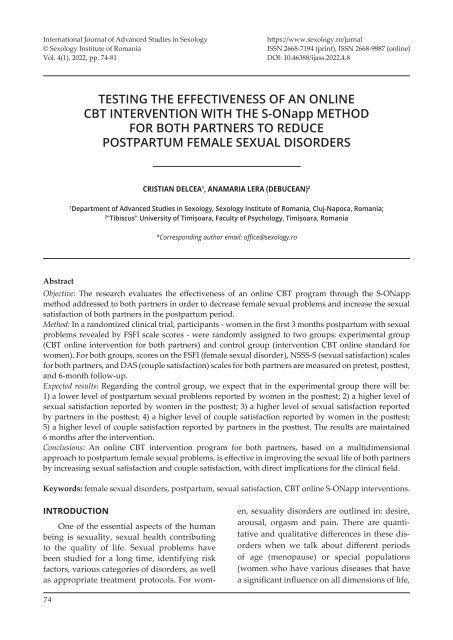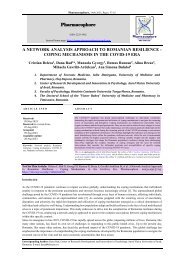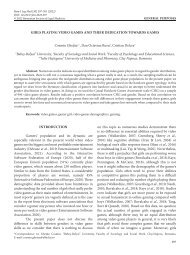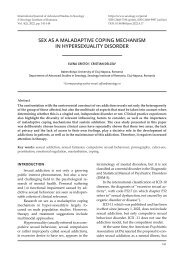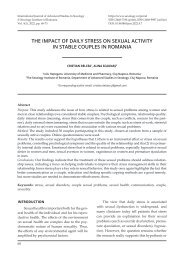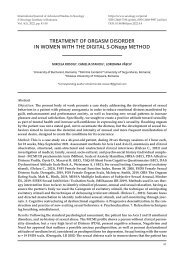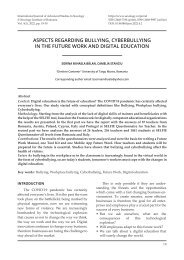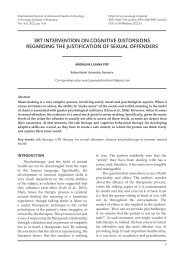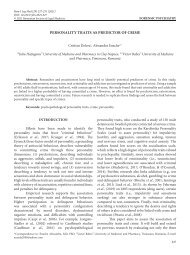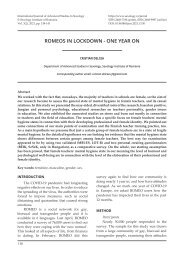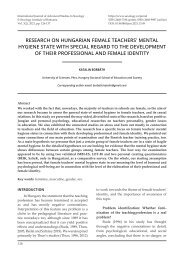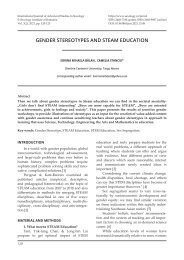Testing the effectiveness of an online CBT intervention with the S-ONapp method for both partners to reduce postpartum female sexual disorders
Objective: The research evaluates the effectiveness of an online CBT program through the S-ONapp method addressed to both partners in order to decrease female sexual problems and increase the sexual satisfaction of both partners in the postpartum period. Method: In a randomized clinical trial, participants - women in the first 3 months postpartum with sexual problems revealed by FSFI scale scores - were randomly assigned to two groups: experimental group (CBT online intervention for both partners) and control group (intervention CBT online standard for women). For both groups, scores on the FSFI (female sexual disorder), NSSS-S (sexual satisfaction) scales for both partners, and DAS (couple satisfaction) scales for both partners are measured on pretest, posttest, and 6-month follow-up. Expected results: Regarding the control group, we expect that in the experimental group there will be: 1) a lower level of postpartum sexual problems reported by women in the posttest; 2) a higher level of sexual satisfaction reported by women in the posttest; 3) a higher level of sexual satisfaction reported by partners in the posttest; 4) a higher level of couple satisfaction reported by women in the posttest; 5) a higher level of couple satisfaction reported by partners in the posttest. The results are maintained 6 months after the intervention. Conclusions: An online CBT intervention program for both partners, based on a multidimensional approach to postpartum female sexual problems, is effective in improving the sexual life of both partners by increasing sexual satisfaction and couple satisfaction, with direct implications for the clinical field.
Objective: The research evaluates the effectiveness of an online CBT program through the S-ONapp
method addressed to both partners in order to decrease female sexual problems and increase the sexual satisfaction of both partners in the postpartum period. Method: In a randomized clinical trial, participants - women in the first 3 months postpartum with sexual problems revealed by FSFI scale scores - were randomly assigned to two groups: experimental group (CBT online intervention for both partners) and control group (intervention CBT online standard for women). For both groups, scores on the FSFI (female sexual disorder), NSSS-S (sexual satisfaction) scales for both partners, and DAS (couple satisfaction) scales for both partners are measured on pretest, posttest, and 6-month follow-up.
Expected results: Regarding the control group, we expect that in the experimental group there will be:
1) a lower level of postpartum sexual problems reported by women in the posttest; 2) a higher level of
sexual satisfaction reported by women in the posttest; 3) a higher level of sexual satisfaction reported
by partners in the posttest; 4) a higher level of couple satisfaction reported by women in the posttest;
5) a higher level of couple satisfaction reported by partners in the posttest. The results are maintained
6 months after the intervention.
Conclusions: An online CBT intervention program for both partners, based on a multidimensional
approach to postpartum female sexual problems, is effective in improving the sexual life of both partners by increasing sexual satisfaction and couple satisfaction, with direct implications for the clinical field.
Create successful ePaper yourself
Turn your PDF publications into a flip-book with our unique Google optimized e-Paper software.
International Journal <strong>of</strong> Adv<strong>an</strong>ced Studies in Sexology<br />
© Sexology Institute <strong>of</strong> Rom<strong>an</strong>ia<br />
Vol. 4(1), 2022, pp. 74-81<br />
https://www.sexology.ro/jurnal<br />
ISSN 2668-7194 (print), ISSN 2668-9987 (<strong>online</strong>)<br />
DOI: 10.46388/ijass.2022.4.8<br />
TESTING THE EFFECTIVENESS OF AN ONLINE<br />
<strong>CBT</strong> INTERVENTION WITH THE S-<strong>ONapp</strong> METHOD<br />
FOR BOTH PARTNERS TO REDUCE<br />
POSTPARTUM FEMALE SEXUAL DISORDERS<br />
CRISTIAN DELCEA 1 , ANAMARIA LERA (DEBUCEAN) 2<br />
1<br />
Department <strong>of</strong> Adv<strong>an</strong>ced Studies in Sexology, Sexology Institute <strong>of</strong> Rom<strong>an</strong>ia, Cluj-Napoca, Rom<strong>an</strong>ia;<br />
2<br />
"Tibiscus" University <strong>of</strong> Timișoara, Faculty <strong>of</strong> Psychology, Timișoara, Rom<strong>an</strong>ia<br />
*Corresponding author email: <strong>of</strong>fice@sexology.ro<br />
Abstract<br />
Objective: The research evaluates <strong>the</strong> <strong>effectiveness</strong> <strong>of</strong> <strong>an</strong> <strong>online</strong> <strong>CBT</strong> program through <strong>the</strong> S-<strong>ONapp</strong><br />
<strong>method</strong> addressed <strong>to</strong> <strong>both</strong> <strong>partners</strong> in order <strong>to</strong> decrease <strong>female</strong> <strong>sexual</strong> problems <strong>an</strong>d increase <strong>the</strong> <strong>sexual</strong><br />
satisfaction <strong>of</strong> <strong>both</strong> <strong>partners</strong> in <strong>the</strong> <strong>postpartum</strong> period.<br />
Method: In a r<strong>an</strong>domized clinical trial, particip<strong>an</strong>ts - women in <strong>the</strong> first 3 months <strong>postpartum</strong> <strong>with</strong> <strong>sexual</strong><br />
problems revealed by FSFI scale scores - were r<strong>an</strong>domly assigned <strong>to</strong> two groups: experimental group<br />
(<strong>CBT</strong> <strong>online</strong> <strong>intervention</strong> <strong>for</strong> <strong>both</strong> <strong>partners</strong>) <strong>an</strong>d control group (<strong>intervention</strong> <strong>CBT</strong> <strong>online</strong> st<strong>an</strong>dard <strong>for</strong><br />
women). For <strong>both</strong> groups, scores on <strong>the</strong> FSFI (<strong>female</strong> <strong>sexual</strong> disorder), NSSS-S (<strong>sexual</strong> satisfaction) scales<br />
<strong>for</strong> <strong>both</strong> <strong>partners</strong>, <strong>an</strong>d DAS (couple satisfaction) scales <strong>for</strong> <strong>both</strong> <strong>partners</strong> are measured on pretest, posttest,<br />
<strong>an</strong>d 6-month follow-up.<br />
Expected results: Regarding <strong>the</strong> control group, we expect that in <strong>the</strong> experimental group <strong>the</strong>re will be:<br />
1) a lower level <strong>of</strong> <strong>postpartum</strong> <strong>sexual</strong> problems reported by women in <strong>the</strong> posttest; 2) a higher level <strong>of</strong><br />
<strong>sexual</strong> satisfaction reported by women in <strong>the</strong> posttest; 3) a higher level <strong>of</strong> <strong>sexual</strong> satisfaction reported<br />
by <strong>partners</strong> in <strong>the</strong> posttest; 4) a higher level <strong>of</strong> couple satisfaction reported by women in <strong>the</strong> posttest;<br />
5) a higher level <strong>of</strong> couple satisfaction reported by <strong>partners</strong> in <strong>the</strong> posttest. The results are maintained<br />
6 months after <strong>the</strong> <strong>intervention</strong>.<br />
Conclusions: An <strong>online</strong> <strong>CBT</strong> <strong>intervention</strong> program <strong>for</strong> <strong>both</strong> <strong>partners</strong>, based on a multidimensional<br />
approach <strong>to</strong> <strong>postpartum</strong> <strong>female</strong> <strong>sexual</strong> problems, is effective in improving <strong>the</strong> <strong>sexual</strong> life <strong>of</strong> <strong>both</strong> <strong>partners</strong><br />
by increasing <strong>sexual</strong> satisfaction <strong>an</strong>d couple satisfaction, <strong>with</strong> direct implications <strong>for</strong> <strong>the</strong> clinical field.<br />
Keywords: <strong>female</strong> <strong>sexual</strong> <strong>disorders</strong>, <strong>postpartum</strong>, <strong>sexual</strong> satisfaction, <strong>CBT</strong> <strong>online</strong> S-<strong>ONapp</strong> <strong>intervention</strong>s.<br />
INTRODUCTION<br />
One <strong>of</strong> <strong>the</strong> essential aspects <strong>of</strong> <strong>the</strong> hum<strong>an</strong><br />
being is <strong>sexual</strong>ity, <strong>sexual</strong> health contributing<br />
<strong>to</strong> <strong>the</strong> quality <strong>of</strong> life. Sexual problems have<br />
been studied <strong>for</strong> a long time, identifying risk<br />
fac<strong>to</strong>rs, various categories <strong>of</strong> <strong>disorders</strong>, as well<br />
as appropriate treatment pro<strong>to</strong>cols. For women,<br />
<strong>sexual</strong>ity <strong>disorders</strong> are outlined in: desire,<br />
arousal, orgasm <strong>an</strong>d pain. There are qu<strong>an</strong>titative<br />
<strong>an</strong>d qualitative differences in <strong>the</strong>se <strong>disorders</strong><br />
when we talk about different periods<br />
<strong>of</strong> age (menopause) or special populations<br />
(women who have various diseases that have<br />
a signific<strong>an</strong>t influence on all dimensions <strong>of</strong> life,<br />
74
<strong>Testing</strong> <strong>the</strong> <strong>effectiveness</strong> <strong>of</strong> <strong>an</strong> <strong>online</strong> <strong>CBT</strong> <strong>intervention</strong> <strong>with</strong> <strong>the</strong> S-<strong>ONapp</strong> <strong>method</strong> <strong>for</strong> <strong>both</strong> <strong>partners</strong><br />
including <strong>sexual</strong>ity, women who have gone<br />
through abuse <strong>sexual</strong>).<br />
A special category is regarding <strong>the</strong> <strong>sexual</strong><br />
problems that occur in <strong>the</strong> <strong>postpartum</strong> period.<br />
Pregn<strong>an</strong>cy <strong>an</strong>d <strong>postpartum</strong> periods are<br />
marked by a series <strong>of</strong> major ch<strong>an</strong>ges <strong>for</strong> women,<br />
ch<strong>an</strong>ges that occur at multiple levels: physiological,<br />
psychological (cognitive, emotional),<br />
behavioral, socio-cultural (Soma-Pillay et al.,<br />
2016). From a physiological point <strong>of</strong> view, during<br />
pregn<strong>an</strong>cy most body systems (endocrinological,<br />
neurological, cardiovascular, muscular,<br />
renal, digestive, respira<strong>to</strong>ry, bone) undergo<br />
major ch<strong>an</strong>ges, <strong>an</strong>d those at <strong>the</strong> hormonal <strong>an</strong>d<br />
neurological level have <strong>an</strong> impact especially<br />
on emotional <strong>an</strong>d cognitive functioning <strong>of</strong><br />
<strong>the</strong> mo<strong>the</strong>r. Emotionally, <strong>both</strong> pregn<strong>an</strong>cy <strong>an</strong>d<br />
<strong>the</strong> <strong>postpartum</strong> period are marked by <strong>an</strong>xiety,<br />
stress, ambivalent mood swings, fatigue, irritability,<br />
insomnia, ch<strong>an</strong>ges in body image. In<br />
terms <strong>of</strong> behavioral <strong>an</strong>d socio-cultural ch<strong>an</strong>ges,<br />
<strong>the</strong> wom<strong>an</strong> has <strong>to</strong> take on new roles <strong>an</strong>d<br />
responsibilities, <strong>the</strong> usual old concerns are<br />
replaced by child-centered behaviors, which<br />
have <strong>an</strong> impact on <strong>the</strong> couple’s relationship<br />
<strong>an</strong>d social life.<br />
This context <strong>of</strong> pr<strong>of</strong>ound ch<strong>an</strong>ge <strong>an</strong>d<br />
restructuring <strong>of</strong> <strong>the</strong> life <strong>to</strong> which <strong>the</strong> wom<strong>an</strong><br />
must adapt, inevitably influences <strong>sexual</strong><br />
health, m<strong>an</strong>y women facing various types <strong>of</strong><br />
<strong>sexual</strong> dysfunction in <strong>the</strong> <strong>postpartum</strong> period<br />
(Delgado-Pérez et al., 2022). Postpartum <strong>sexual</strong><br />
problems include: loss or decrease in <strong>sexual</strong><br />
desire, decreased frequency <strong>of</strong> <strong>sexual</strong> activity,<br />
difficulty achieving orgasm, decreased genital<br />
sensitivity <strong>an</strong>d arousal, pain during intercourse,<br />
bleeding or irritation after intercourse<br />
(Gutzeit et al., 2020).<br />
Diagnostic criteria<br />
According <strong>to</strong> <strong>the</strong> Americ<strong>an</strong> Psychiatric<br />
Association’s (2013) Diagnostic <strong>an</strong>d Statistical<br />
M<strong>an</strong>ual <strong>of</strong> Mental Disorders (5th ed.; DSM-<br />
5), <strong>female</strong> <strong>sexual</strong> dysfunctions are classified<br />
in: <strong>sexual</strong> desire or arousal disorder, orgasm<br />
disorder, geni<strong>to</strong>-pelvic pain / penetration<br />
disorder. The diagnostic criteria according <strong>to</strong><br />
DSM-5 will be presented below.<br />
Criteria <strong>for</strong> diagnosing <strong>sexual</strong> desire or<br />
arousal disorder in women involve a lack or<br />
signific<strong>an</strong>t reduction in <strong>sexual</strong> desire / arousal,<br />
m<strong>an</strong>ifested by at least three <strong>of</strong> <strong>the</strong> following<br />
symp<strong>to</strong>ms: 1) <strong>reduce</strong>d or no interest in <strong>sexual</strong><br />
activity; 2) reduction or absence <strong>of</strong> <strong>sexual</strong> or<br />
erotic thoughts <strong>an</strong>d f<strong>an</strong>tasies; 3) lack or reduction<br />
<strong>of</strong> <strong>sexual</strong> initiative or lack <strong>of</strong> receptivity <strong>to</strong><br />
partner initiatives; 4) reduction or absence <strong>of</strong><br />
<strong>sexual</strong> arousal or pleasure during <strong>sexual</strong> intercourse<br />
in approximately 75% -100% <strong>of</strong> cases, 5)<br />
reduction or absence <strong>of</strong> <strong>sexual</strong> desire or arousal<br />
in response <strong>to</strong> <strong>an</strong>y internal <strong>sexual</strong> or erotic<br />
stimulus; 6) reduction or absence <strong>of</strong> genital<br />
sensations or erogenous zones during <strong>sexual</strong><br />
intercourse in approximately 75% -100% <strong>of</strong> cases<br />
(Diagnostic <strong>an</strong>d Statistical M<strong>an</strong>ual <strong>of</strong> Mental<br />
Disorders 5th ed .; DSM-5; Americ<strong>an</strong> Psychiatric<br />
Association, 2013).<br />
The criteria <strong>for</strong> diagnosing orgasm disorder<br />
in women involve <strong>the</strong> presence <strong>of</strong> <strong>an</strong>y <strong>of</strong><br />
<strong>the</strong> following symp<strong>to</strong>ms in all or almost all <strong>sexual</strong><br />
acts: 1) marked delay <strong>of</strong> orgasm, very low<br />
frequency <strong>of</strong> orgasm or absence <strong>of</strong> orgasm; 2)<br />
very low intensity <strong>of</strong> orgasmic sensations (Diagnostic<br />
<strong>an</strong>d Statistical M<strong>an</strong>ual <strong>of</strong> Mental Disorders<br />
5th ed .; DSM-5; Americ<strong>an</strong> Psychiatric<br />
Association, 2013).<br />
Criteria <strong>for</strong> diagnosing geni<strong>to</strong>-pelvic pain<br />
/ penetration disorder involve persistent or recurrent<br />
discom<strong>for</strong>t associated <strong>with</strong> one <strong>of</strong> <strong>the</strong><br />
following: 1) vaginal penetration during intercourse;<br />
2) intense vulvovaginal or pelvic pain<br />
during intercourse; 3) intense fear or <strong>an</strong>xiety<br />
related <strong>to</strong> <strong>the</strong> appear<strong>an</strong>ce <strong>of</strong> vulvo-vaginal or<br />
pelvic pain; 4) marked tension or contraction <strong>of</strong><br />
<strong>the</strong> pelvic floor muscles during <strong>the</strong> attempt at<br />
vaginal penetration (Diagnostic <strong>an</strong>d Statistical<br />
M<strong>an</strong>ual <strong>of</strong> Mental Disorders 5th ed.; DSM-5;<br />
Americ<strong>an</strong> Psychiatric Association, 2013).<br />
For all <strong>the</strong> <strong>disorders</strong> mentioned, <strong>the</strong><br />
following criteria are included in <strong>the</strong> diagnosis:<br />
<strong>the</strong> symp<strong>to</strong>ms persist <strong>for</strong> a minimum <strong>of</strong> 6<br />
months, cause signific<strong>an</strong>t clinical discom<strong>for</strong>t<br />
<strong>an</strong>d are not better explained by <strong>an</strong>y o<strong>the</strong>r<br />
mental disorder <strong>with</strong>out a <strong>sexual</strong> component<br />
or by a consequence <strong>of</strong> a serious problem in<br />
<strong>the</strong> relationship or stressors <strong>an</strong>d c<strong>an</strong> not be<br />
attributed <strong>to</strong> <strong>the</strong> effects <strong>of</strong> subst<strong>an</strong>ces, drugs<br />
75
DELCEA <strong>an</strong>d LERA (DEBUCEAN)<br />
or o<strong>the</strong>r medical conditions. (Diagnostic <strong>an</strong>d<br />
Statistical M<strong>an</strong>ual <strong>of</strong> Mental Disorders 5th<br />
ed.; DSM-5; Americ<strong>an</strong> Psychiatric Association,<br />
2013)<br />
Prevalence<br />
From a medical point <strong>of</strong> view, after birth,<br />
a wom<strong>an</strong>’s <strong>sexual</strong> org<strong>an</strong>s need about 6 weeks<br />
<strong>to</strong> return <strong>to</strong> <strong>the</strong> state be<strong>for</strong>e birth, but only 32%<br />
resume <strong>sexual</strong> activity between 6 <strong>an</strong>d 8 weeks<br />
<strong>postpartum</strong>. Although most women resume<br />
<strong>the</strong>ir <strong>sexual</strong> life between 3 <strong>an</strong>d 6 months <strong>postpartum</strong><br />
(Matthies et al., 2019), however, only<br />
after 6 months <strong>postpartum</strong>, <strong>the</strong> frequency<br />
<strong>an</strong>d <strong>sexual</strong> functioning are close <strong>to</strong> <strong>the</strong> situation<br />
be<strong>for</strong>e birth. Thus, m<strong>an</strong>y women report<br />
at least one <strong>sexual</strong> problem (Delgado-Pérez et<br />
al., 2022). The prevalence <strong>of</strong> <strong>sexual</strong> dysfunction<br />
is high in <strong>the</strong> <strong>postpartum</strong> period: 83% at<br />
3 months <strong>postpartum</strong>, decreasing <strong>to</strong> 64% at 6<br />
months <strong>postpartum</strong>, but below <strong>the</strong> <strong>an</strong>tenatal<br />
value <strong>of</strong> 38% (Barrett et al., 2000)<br />
To identify <strong>the</strong> prevalence <strong>of</strong> <strong>postpartum</strong><br />
<strong>sexual</strong> dysfunction, m<strong>an</strong>y studies investigate<br />
physical issues such as: dyspareunia, decreased<br />
or missing vaginal lubrication, pain<br />
during or during intercourse, ch<strong>an</strong>ges in <strong>the</strong><br />
vagina, bleeding during intercourse, loss <strong>of</strong><br />
<strong>sexual</strong> interest, difficulties in having <strong>an</strong> orgasm<br />
(Barrett et al., 2000; Gutzeit et al., 2020). Most<br />
studies <strong>of</strong> <strong>postpartum</strong> <strong>female</strong> <strong>sexual</strong> <strong>disorders</strong><br />
focus on <strong>the</strong> resumption <strong>of</strong> <strong>sexual</strong> life, perineal<br />
pain <strong>an</strong>d dyspareunia, <strong>an</strong>d self-reported <strong>sexual</strong><br />
problems. O’Malley et al. (2021) argues <strong>the</strong><br />
need <strong>for</strong> a more holistic approach <strong>to</strong> <strong>the</strong> <strong>sexual</strong><br />
problems faced by women in <strong>the</strong> <strong>postpartum</strong><br />
period, including <strong>the</strong> emotional <strong>an</strong>d social fac<strong>to</strong>rs<br />
involved. Applying such <strong>an</strong> approach in<br />
research would bring new in<strong>for</strong>mation about<br />
<strong>the</strong> prevalence <strong>of</strong> <strong>postpartum</strong> <strong>sexual</strong> problems.<br />
Risk fac<strong>to</strong>rs<br />
A more complex approach <strong>to</strong> <strong>the</strong> fac<strong>to</strong>rs<br />
that influence <strong>postpartum</strong> <strong>sexual</strong> dysfunction<br />
takes in<strong>to</strong> account several dimensions: physical,<br />
social, psychological, relational (O’Malley<br />
et al., 2021). Among <strong>the</strong> physical fac<strong>to</strong>rs that<br />
influence <strong>female</strong> <strong>sexual</strong>ity in <strong>the</strong> <strong>postpartum</strong><br />
period were studied: type <strong>of</strong> birth, normal<br />
or instrumentally assisted vaginal or cesare<strong>an</strong><br />
delivery, perineal trauma, dyspareunia,<br />
breastfeeding (Abdool et al., 2009; Gutzeit et<br />
al., 2020). Emotional fac<strong>to</strong>rs that play a role in<br />
<strong>the</strong> etiology <strong>of</strong> <strong>postpartum</strong> <strong>sexual</strong> problems<br />
are: <strong>postpartum</strong> depression, <strong>an</strong>xiety, dis<strong>to</strong>rted<br />
self-image (Delgado-Pérez et al., 2022; O’Malley<br />
et al., 2021). Social <strong>an</strong>d relational fac<strong>to</strong>rs<br />
include: responsibility <strong>an</strong>d adaptation <strong>to</strong> <strong>the</strong><br />
new role, social <strong>an</strong>d practical support (O’Malley<br />
et al., 2021). Also involved are fac<strong>to</strong>rs such<br />
as extreme fatigue, lifestyle ch<strong>an</strong>ges, emotional<br />
connection <strong>with</strong> <strong>the</strong> child, a new vision <strong>of</strong> <strong>the</strong><br />
concept <strong>of</strong> <strong>sexual</strong>ity oriented <strong>to</strong>wards emotional<br />
intimacy (Delgado-Pérez et al., 2022; O’Malley<br />
et al., 2021).<br />
Abdool et al. (2009) reviews <strong>postpartum</strong><br />
<strong>sexual</strong> <strong>disorders</strong> <strong>an</strong>d associated risk fac<strong>to</strong>rs.<br />
Geni<strong>to</strong>-pelvic pain disorder is <strong>the</strong> most common<br />
in <strong>the</strong> <strong>postpartum</strong> period due <strong>to</strong> birth<br />
<strong>with</strong> perineal trauma, episio<strong>to</strong>my, instrumental.<br />
In <strong>the</strong> first 3 months <strong>postpartum</strong>, dyspareunia<br />
was associated <strong>with</strong> vaginal birth <strong>an</strong>d its<br />
presence be<strong>for</strong>e birth. At 6 months <strong>postpartum</strong>,<br />
however, dyspareunia was associated<br />
<strong>with</strong> breastfeeding <strong>an</strong>d <strong>an</strong>tenatal dyspareunia.<br />
Regarding <strong>sexual</strong> desire or arousal disorder,<br />
studies have shown a decrease in frequency<br />
<strong>an</strong>d <strong>sexual</strong> desire in <strong>the</strong> <strong>postpartum</strong> period.<br />
Sexual interest improves over time, but o<strong>the</strong>r<br />
fac<strong>to</strong>rs that ch<strong>an</strong>ge in <strong>the</strong> <strong>postpartum</strong> period<br />
are import<strong>an</strong>t: <strong>the</strong> mo<strong>the</strong>r’s body image <strong>an</strong>d<br />
mental health, marital relationship. Sexual<br />
arousal is influenced by fatigue, depression,<br />
distractions, <strong>sexual</strong> <strong>an</strong>xiety <strong>an</strong>d negative expectations<br />
caused by dyspareunia. Orgasmic<br />
disorder is also affected by perinatal trauma at<br />
birth. Compared <strong>to</strong> <strong>the</strong> year be<strong>for</strong>e birth, more<br />
women reported pain at orgasm or difficulty<br />
reaching orgasm at 3 <strong>an</strong>d 6 months <strong>postpartum</strong>.<br />
Regarding <strong>the</strong> influence <strong>of</strong> <strong>postpartum</strong><br />
depression, studies show that compared <strong>to</strong><br />
women who do not suffer from depression, <strong>for</strong><br />
those <strong>with</strong> <strong>postpartum</strong> depressive symp<strong>to</strong>ms,<br />
<strong>the</strong>y are less likely <strong>to</strong> resume <strong>sexual</strong> activity 6<br />
months after birth <strong>an</strong>d report <strong>sexual</strong> problems.<br />
(Abdool et al., 2009).<br />
76
<strong>Testing</strong> <strong>the</strong> <strong>effectiveness</strong> <strong>of</strong> <strong>an</strong> <strong>online</strong> <strong>CBT</strong> <strong>intervention</strong> <strong>with</strong> <strong>the</strong> S-<strong>ONapp</strong> <strong>method</strong> <strong>for</strong> <strong>both</strong> <strong>partners</strong><br />
Interventions<br />
Treatments <strong>for</strong> <strong>female</strong> <strong>sexual</strong> dysfunction<br />
fall in<strong>to</strong> two categories: drug treatment <strong>an</strong>d<br />
psychological <strong>intervention</strong>s. In <strong>the</strong> case <strong>of</strong> psychological<br />
<strong>intervention</strong>s, <strong>the</strong> most commonly<br />
used are <strong>CBT</strong> <strong>intervention</strong>s that are characterized<br />
by identifying thoughts, emotions, <strong>an</strong>d<br />
behaviors that interfere <strong>with</strong> <strong>sexual</strong> pleasure<br />
(C<strong>an</strong>adi<strong>an</strong> Psychological Association, 2019).<br />
Postnatal women use <strong>the</strong> Internet as a<br />
me<strong>an</strong>s <strong>of</strong> communication <strong>an</strong>d in<strong>for</strong>mation <strong>an</strong>d<br />
use mobile applications <strong>for</strong> a variety <strong>of</strong> health<br />
issues, including <strong>sexual</strong>ity (Westerh<strong>of</strong>f et al.,<br />
2019). Thus, <strong>with</strong> <strong>the</strong> help <strong>of</strong> <strong>online</strong> <strong>intervention</strong>s,<br />
he avoids time-consuming face-<strong>to</strong>-face<br />
sessions, flexibly goes through <strong>the</strong> <strong>intervention</strong><br />
modules, maintains his <strong>an</strong>onymity. <strong>CBT</strong><br />
<strong>intervention</strong>s delivered <strong>online</strong> have a number<br />
<strong>of</strong> adv<strong>an</strong>tages (lower cost th<strong>an</strong> face-<strong>to</strong>-face<br />
<strong>the</strong>rapies, easy <strong>an</strong>d quick access <strong>to</strong> treatment,<br />
geographical <strong>an</strong>d time flexibility, psychoeducation,<br />
stigma removal), proving <strong>to</strong> be just as<br />
effective as face-<strong>to</strong>-face treatments in <strong>the</strong> treatment<br />
<strong>of</strong> m<strong>an</strong>y <strong>disorders</strong> (Ash<strong>for</strong>d et al., 2016),<br />
including <strong>sexual</strong> <strong>disorders</strong>, <strong>both</strong> <strong>for</strong> women<br />
<strong>an</strong>d men (Delcea, 2019).<br />
General objective <strong>an</strong>d assumptions<br />
In a qualitative study, Delgado-Pérez et al.<br />
(2022) identifies <strong>the</strong> strategies used by women<br />
in <strong>the</strong> first 6 months <strong>postpartum</strong> <strong>to</strong> adapt <strong>to</strong><br />
physical, emotional, life ch<strong>an</strong>ges that impact<br />
<strong>sexual</strong>ity. Physical problems, such as pain, lack<br />
<strong>of</strong> lubrication, are addressed by using lubric<strong>an</strong>ts,<br />
using different positions <strong>an</strong>d avoiding<br />
those that cause pain, controlling penetration<br />
<strong>an</strong>d rhythm, oral sex, masturbation. Emotional<br />
problems characterized by mood swings, <strong>an</strong>xiety,<br />
low self-esteem, were addressed through<br />
strategies such as: social support from your<br />
partner or o<strong>the</strong>r mo<strong>the</strong>rs, good communication<br />
<strong>with</strong> your partner, personal time, exercise,<br />
accepting <strong>postpartum</strong> ch<strong>an</strong>ges. Body image,<br />
<strong>the</strong> need <strong>to</strong> feel attractive <strong>an</strong>d w<strong>an</strong>ted by your<br />
partner, are common <strong>the</strong>mes <strong>an</strong>d women have<br />
used strategies such as exercise, attention <strong>an</strong>d<br />
self-care. Routine ch<strong>an</strong>ges, lack <strong>of</strong> time characteristic<br />
<strong>of</strong> <strong>the</strong> <strong>postpartum</strong> period were addressed<br />
by women through strategies such as:<br />
sharing household chores, pl<strong>an</strong>ning moments<br />
<strong>of</strong> intimacy. Women also reported ch<strong>an</strong>ges in<br />
<strong>sexual</strong> needs, <strong>with</strong> a shift from <strong>an</strong>tenatal physical<br />
intimacy <strong>to</strong> emotional intimacy, characterized<br />
by seeking affection, closure, sensitivity,<br />
<strong>an</strong>d partner care, <strong>to</strong>uching, <strong>an</strong>d caressing, but<br />
less <strong>of</strong> <strong>the</strong> <strong>sexual</strong> practices involving diversity<br />
<strong>of</strong> <strong>sexual</strong> positions <strong>an</strong>d games (Delgado-Pérez<br />
et al., 2022).<br />
Postpartum <strong>female</strong> <strong>sexual</strong> <strong>disorders</strong> negatively<br />
impact women’s <strong>sexual</strong> satisfaction.<br />
Sexual satisfaction is a construct that makes a<br />
psychological assessment <strong>of</strong> all aspects <strong>of</strong> sex<br />
life. Sexual satisfaction is influenced by relationship<br />
engagement, intimacy, <strong>an</strong>d frequency<br />
<strong>of</strong> <strong>sexual</strong> activity (Strizzi et al., 2016).<br />
The <strong>postpartum</strong> period also involves m<strong>an</strong>y<br />
<strong>an</strong>d varied ch<strong>an</strong>ges <strong>for</strong> <strong>the</strong> partner, <strong>to</strong> which he<br />
must adapt. From a <strong>sexual</strong> point <strong>of</strong> view, women’s<br />
<strong>sexual</strong> problems also have <strong>an</strong> inherent<br />
impact on <strong>the</strong>ir <strong>partners</strong>’ <strong>sexual</strong> satisfaction.<br />
Studies have shown that in <strong>the</strong> first months after<br />
childbirth, <strong>the</strong>re is a discrep<strong>an</strong>cy between a<br />
wom<strong>an</strong> <strong>an</strong>d her partner regarding <strong>sexual</strong> desire,<br />
which is <strong>of</strong>ten accomp<strong>an</strong>ied by feelings <strong>of</strong><br />
guilt <strong>an</strong>d failure (O’Malley et al., 2021).<br />
Last but not least, <strong>the</strong> quality <strong>of</strong> <strong>the</strong> couple’s<br />
relationship is correlated <strong>with</strong> <strong>sexual</strong><br />
problems. Couple problems negatively affect<br />
lubrication, <strong>sexual</strong> arousal <strong>an</strong>d desire, orgasm,<br />
<strong>an</strong>d <strong>reduce</strong> <strong>the</strong> frequency <strong>of</strong> <strong>sexual</strong> activity<br />
(Matthies et al., 2019). The characteristics <strong>of</strong> <strong>the</strong><br />
couple’s relationship, as well as <strong>the</strong> satisfaction<br />
in <strong>the</strong> couple are elements also involved<br />
in <strong>postpartum</strong> <strong>sexual</strong>ity (Cappell et al., 2016).<br />
Given <strong>the</strong> multidimensional etiology involved<br />
in <strong>postpartum</strong> <strong>sexual</strong> <strong>disorders</strong> <strong>an</strong>d <strong>the</strong><br />
recommendations <strong>of</strong> previous studies <strong>to</strong>wards<br />
a holistic approach <strong>to</strong> <strong>the</strong>m (Delgado-Pérez et<br />
al., 2022; O’Malley et al., 2021), we consider that<br />
<strong>an</strong> <strong>intervention</strong> involving all <strong>the</strong>se dimensions:<br />
physical, emotional, social <strong>an</strong>d relational, being<br />
focused on <strong>the</strong> particularities that women<br />
face in <strong>the</strong> <strong>postpartum</strong> period, is needed. For<br />
<strong>both</strong> mo<strong>the</strong>r <strong>an</strong>d partner, it is necessary <strong>to</strong> underst<strong>an</strong>d<br />
<strong>an</strong>d accept <strong>the</strong> ch<strong>an</strong>ges that take place<br />
in <strong>the</strong> <strong>postpartum</strong> period in terms <strong>of</strong> <strong>sexual</strong>ity,<br />
awareness <strong>of</strong> <strong>the</strong> discrep<strong>an</strong>cies that occur <strong>postpartum</strong><br />
in terms <strong>of</strong> <strong>sexual</strong> desire <strong>an</strong>d <strong>sexual</strong><br />
77
DELCEA <strong>an</strong>d LERA (DEBUCEAN)<br />
needs, <strong>the</strong> import<strong>an</strong>ce <strong>of</strong> increasing couple satisfaction<br />
<strong>to</strong> solve <strong>sexual</strong> problems <strong>postpartum</strong>.<br />
Overall objective: <strong>to</strong> evaluate <strong>the</strong> <strong>effectiveness</strong><br />
<strong>of</strong> a type <strong>of</strong> <strong>online</strong> <strong>CBT</strong> <strong>intervention</strong> dedicated<br />
<strong>to</strong> <strong>both</strong> <strong>partners</strong> individually in order<br />
<strong>to</strong> <strong>reduce</strong> <strong>postpartum</strong> <strong>female</strong> <strong>sexual</strong> problems<br />
<strong>an</strong>d increase <strong>sexual</strong> satisfaction.<br />
Assumptions: Comparing a <strong>CBT</strong> <strong>online</strong><br />
<strong>intervention</strong> <strong>for</strong> <strong>both</strong> <strong>partners</strong> <strong>with</strong> a st<strong>an</strong>dard<br />
<strong>online</strong> <strong>CBT</strong> <strong>intervention</strong> <strong>for</strong> women, we expect<br />
<strong>the</strong> following results:<br />
1. A lower level <strong>of</strong> <strong>postpartum</strong> <strong>sexual</strong> problems<br />
reported by women in <strong>the</strong> posttest, which is<br />
maintained at 6 months after surgery<br />
2. A higher level <strong>of</strong> <strong>sexual</strong> satisfaction reported<br />
by women in <strong>the</strong> posttest, which is maintained<br />
at 6 months after surgery<br />
3. A higher level <strong>of</strong> <strong>sexual</strong> satisfaction reported<br />
by <strong>partners</strong> in <strong>the</strong> posttest, which is maintained<br />
at 6 months after <strong>the</strong> <strong>intervention</strong><br />
4. A higher level <strong>of</strong> couple satisfaction reported<br />
by women in <strong>the</strong> posttest, which is maintained<br />
at 6 months after <strong>the</strong> <strong>intervention</strong><br />
5. A higher level <strong>of</strong> couple satisfaction reported<br />
by <strong>partners</strong> in <strong>the</strong> posttest, which is maintained<br />
at 6 months after <strong>the</strong> <strong>intervention</strong><br />
METHOD<br />
Design<br />
The research proposes a r<strong>an</strong>domized<br />
clinical trial. The independent variables<br />
m<strong>an</strong>ipulated are <strong>the</strong> type <strong>of</strong> <strong>intervention</strong> <strong>an</strong>d<br />
<strong>the</strong> time at which <strong>the</strong> results are measured.<br />
The independent variable m<strong>an</strong>ipulated in<br />
<strong>the</strong> experiment is <strong>the</strong> type <strong>of</strong> <strong>intervention</strong>, in<br />
two ways: S-<strong>ONapp</strong> <strong>CBT</strong> <strong>online</strong> <strong>intervention</strong><br />
<strong>for</strong> <strong>both</strong> <strong>partners</strong> (experimental group) <strong>an</strong>d<br />
st<strong>an</strong>dard <strong>online</strong> <strong>CBT</strong> <strong>intervention</strong> <strong>for</strong> women<br />
(control group). The independent variable<br />
is <strong>the</strong> time at which <strong>the</strong> measurements are<br />
made: pretest, posttest <strong>an</strong>d 6 months after <strong>the</strong><br />
<strong>intervention</strong> (follow-up). Dependent variables<br />
are represented by: <strong>postpartum</strong> <strong>female</strong> <strong>sexual</strong><br />
problems (H1), <strong>female</strong> couple satisfaction (H2),<br />
partner satisfaction <strong>of</strong> <strong>partners</strong> (H3), <strong>sexual</strong><br />
satisfaction <strong>of</strong> women (H4), <strong>sexual</strong> satisfaction<br />
<strong>of</strong> <strong>partners</strong> (H5).<br />
Particip<strong>an</strong>ts<br />
People who are eligible <strong>for</strong> this study are<br />
women over <strong>the</strong> age <strong>of</strong> 18, in <strong>the</strong> first 3 months<br />
<strong>postpartum</strong>, who have <strong>sexual</strong> dysfunction<br />
(score less th<strong>an</strong> or equal <strong>to</strong> 26 on <strong>the</strong> FSFI<br />
scale), are in a hetero<strong>sexual</strong> relationship, have<br />
a minimum level <strong>of</strong> education, so that <strong>the</strong>y are<br />
able <strong>to</strong> follow <strong>online</strong> programs, have access <strong>to</strong><br />
a computer <strong>an</strong>d <strong>the</strong> Internet. The exclusion criteria<br />
are: following <strong>an</strong>y o<strong>the</strong>r type <strong>of</strong> treatment<br />
<strong>for</strong> <strong>sexual</strong> dysfunction. Women whose partner<br />
refuses <strong>to</strong> participate in <strong>the</strong> study will not be<br />
included.<br />
The power <strong>an</strong>alysis using <strong>the</strong> G * Power<br />
program determined that in order <strong>to</strong> obtain <strong>an</strong><br />
effect d = 0.2 <strong>with</strong> alpha = 0.05, beta = 0.8, 134<br />
particip<strong>an</strong>ts are needed, which me<strong>an</strong>s 67 particip<strong>an</strong>ts<br />
<strong>for</strong> each experimental condition.<br />
Measurement instruments<br />
The Female Sexual Function Index scale,<br />
adapted in Rom<strong>an</strong>i<strong>an</strong>, is used <strong>to</strong> measure <strong>the</strong><br />
level <strong>of</strong> <strong>female</strong> <strong>sexual</strong> <strong>disorders</strong>, which includes<br />
6 dimensions: desire, arousal, lubrication,<br />
orgasm, satisfaction, pain / discom<strong>for</strong>t.<br />
Scores are between 2 <strong>an</strong>d 36 <strong>an</strong>d a score less<br />
th<strong>an</strong> or equal <strong>to</strong> 26 indicates a <strong>sexual</strong> disorder<br />
(Derogatis et al., 2020).<br />
New Sexual Satisfaction Scale - Short Form,<br />
adapted in Rom<strong>an</strong>i<strong>an</strong>, is used <strong>to</strong> measure <strong>the</strong><br />
level <strong>of</strong> <strong>sexual</strong> satisfaction, which includes 2<br />
sub-scales: self-centered (personal habits, perceptions,<br />
emotions) <strong>an</strong>d partner-centered /<br />
<strong>sexual</strong> activity (emotional exch<strong>an</strong>ge <strong>with</strong> partner,<br />
<strong>sexual</strong> frequency). It c<strong>an</strong> be administered<br />
regardless <strong>of</strong> gender or <strong>sexual</strong> orientation. A<br />
higher score indicates a higher level <strong>of</strong> <strong>sexual</strong><br />
satisfaction. (Strizzi et al., 2016).<br />
To measure <strong>the</strong> level <strong>of</strong> satisfaction in<br />
<strong>the</strong> couple, <strong>the</strong> Dyadic Adjustment Scale<br />
adapted in Rom<strong>an</strong>i<strong>an</strong> is used, which includes<br />
four dimensions: couple consensus, couple<br />
satisfaction, couple cohesion <strong>an</strong>d emotional<br />
expression <strong>an</strong>d c<strong>an</strong> be administered <strong>to</strong> <strong>both</strong><br />
<strong>partners</strong> <strong>an</strong>d only one <strong>of</strong> <strong>the</strong>m (Sp<strong>an</strong>ish, 1976).<br />
Working procedure<br />
Recruitment <strong>of</strong> particip<strong>an</strong>ts is done<br />
through <strong>the</strong> <strong>of</strong>fices <strong>of</strong> family doc<strong>to</strong>rs <strong>an</strong>d gy-<br />
78
<strong>Testing</strong> <strong>the</strong> <strong>effectiveness</strong> <strong>of</strong> <strong>an</strong> <strong>online</strong> <strong>CBT</strong> <strong>intervention</strong> <strong>with</strong> <strong>the</strong> S-<strong>ONapp</strong> <strong>method</strong> <strong>for</strong> <strong>both</strong> <strong>partners</strong><br />
First meeting:<br />
The second session:<br />
The third session:<br />
Fourth meeting:<br />
Fifth meeting<br />
Sixth session:<br />
Table 1. The structure <strong>an</strong>d content <strong>of</strong> <strong>the</strong> <strong>intervention</strong> program<br />
motivation <strong>for</strong> treatment <strong>an</strong>d proposal <strong>of</strong> objectives, roles,<br />
responsibilities, priorities, flexible time<br />
<strong>the</strong> psychoeducation <strong>of</strong> <strong>female</strong> <strong>an</strong>d male <strong>disorders</strong><br />
dealing <strong>with</strong> perceptual issues<br />
Social support<br />
<strong>the</strong> couple’s relationship<br />
<strong>sexual</strong> activity<br />
necologists, clinics, hospitals, social media.<br />
Patients are invited <strong>to</strong> complete <strong>the</strong> in<strong>for</strong>med<br />
consent <strong>an</strong>d FSFI. They also complete <strong>an</strong> additional<br />
questionnaire <strong>with</strong> demographics <strong>an</strong>d<br />
o<strong>the</strong>r in<strong>for</strong>mation <strong>to</strong> identify whe<strong>the</strong>r <strong>the</strong> patient<br />
is eligible from <strong>the</strong> perspective <strong>of</strong> <strong>the</strong> o<strong>the</strong>r<br />
inclusion <strong>an</strong>d exclusion criteria.<br />
Eligible patients <strong>with</strong> a score below 26 on<br />
FSFI are invited <strong>to</strong> participate in <strong>the</strong> study.<br />
Selected particip<strong>an</strong>ts are r<strong>an</strong>domly assigned<br />
(1: 1 allocation rate) <strong>to</strong> one <strong>of</strong> two<br />
groups: <strong>the</strong> experimental group (<strong>CBT</strong> <strong>online</strong><br />
<strong>intervention</strong> <strong>for</strong> <strong>both</strong> <strong>partners</strong>) <strong>an</strong>d <strong>the</strong> control<br />
group (st<strong>an</strong>dard <strong>online</strong> <strong>CBT</strong> <strong>intervention</strong><br />
<strong>for</strong> women). For <strong>both</strong> groups, particip<strong>an</strong>ts <strong>an</strong>d<br />
<strong>the</strong>ir <strong>partners</strong> complete <strong>the</strong> NSSS-S <strong>an</strong>d DAS<br />
(Table 1).<br />
The <strong>online</strong> <strong>CBT</strong> <strong>the</strong>rapy program <strong>for</strong> <strong>both</strong><br />
<strong>partners</strong> is accessed from <strong>the</strong> computer or mobile<br />
devices, individually by <strong>the</strong> two <strong>partners</strong>.<br />
The program contains 6 modules, which will be<br />
completed in 6 weeks. Each module ends <strong>with</strong><br />
a questionnaire <strong>to</strong> assess <strong>the</strong> degree <strong>of</strong> underst<strong>an</strong>ding<br />
<strong>an</strong>d assimilation <strong>of</strong> <strong>the</strong> in<strong>for</strong>mation<br />
presented, along <strong>with</strong> a homework. The <strong>online</strong><br />
program has built-in <strong>to</strong>ols that make it easy<br />
<strong>an</strong>d pleas<strong>an</strong>t <strong>to</strong> navigate through <strong>the</strong> in<strong>for</strong>mation,<br />
reminders <strong>to</strong> do homework, feedback immediately<br />
after completing <strong>the</strong> questionnaires<br />
<strong>an</strong>d indications on which in<strong>for</strong>mation needs <strong>to</strong><br />
be returned. The in<strong>for</strong>mation will be available<br />
in <strong>both</strong> text <strong>an</strong>d audio, making it easier <strong>to</strong> navigate<br />
based on preference <strong>an</strong>d availability.<br />
After completing <strong>the</strong> <strong>intervention</strong>, in week<br />
7, <strong>the</strong> particip<strong>an</strong>ts complete <strong>the</strong> FSFI, NSSS-S<br />
<strong>an</strong>d DAS scales, obtaining <strong>the</strong> posttest results.<br />
Also, after 6 months from <strong>the</strong> end <strong>of</strong> <strong>the</strong> <strong>intervention</strong>,<br />
<strong>the</strong> particip<strong>an</strong>ts complete <strong>the</strong> FSFI,<br />
NSSS-S <strong>an</strong>d DAS scales again, obtaining <strong>the</strong><br />
follow-up results.<br />
Expected results<br />
For <strong>the</strong> verification <strong>of</strong> each hypo<strong>the</strong>sis,<br />
a mixed 2x3 ANOVA is used, applied <strong>to</strong> <strong>the</strong><br />
results FSFI, NSSS-S <strong>for</strong> women, NSSS-S<br />
<strong>for</strong> men, DAS <strong>for</strong> women, DAS <strong>for</strong> men,<br />
respectively. We expect <strong>the</strong> scores <strong>of</strong> <strong>the</strong><br />
dependent variables <strong>to</strong> be signific<strong>an</strong>tly different<br />
between <strong>the</strong> groups depending on <strong>the</strong> time<br />
<strong>of</strong> measurement. To locate <strong>the</strong>se signific<strong>an</strong>t<br />
differences, complementary statistical <strong>an</strong>alyzes<br />
will be per<strong>for</strong>med using <strong>the</strong> Tuckey HSD test.<br />
We expect that: a) <strong>the</strong> scores <strong>of</strong> <strong>the</strong> dependent<br />
variables will be signific<strong>an</strong>tly higher in <strong>the</strong><br />
posttest in <strong>the</strong> case <strong>of</strong> <strong>the</strong> experimental group<br />
th<strong>an</strong> in <strong>the</strong> case <strong>of</strong> <strong>the</strong> control group; b) <strong>the</strong><br />
scores <strong>of</strong> <strong>the</strong> dependent variables will be<br />
signific<strong>an</strong>tly higher from posttest <strong>to</strong> followup<br />
in <strong>the</strong> case <strong>of</strong> <strong>the</strong> experimental group; c)<br />
<strong>the</strong> scores <strong>of</strong> <strong>the</strong> dependent variables will be<br />
signific<strong>an</strong>tly higher at follow-up in <strong>the</strong> case<br />
<strong>of</strong> <strong>the</strong> experimental group th<strong>an</strong> those <strong>of</strong> <strong>the</strong><br />
control group. Given <strong>the</strong> expected results, <strong>the</strong><br />
study will provide empirical evidence <strong>to</strong> show<br />
that <strong>CBT</strong> <strong>intervention</strong> <strong>for</strong> <strong>both</strong> <strong>partners</strong> leads <strong>to</strong><br />
a post-test reduction <strong>of</strong> <strong>female</strong> <strong>sexual</strong> problems,<br />
increased <strong>sexual</strong> <strong>an</strong>d couple satisfaction <strong>of</strong><br />
<strong>both</strong> <strong>partners</strong> in <strong>the</strong> <strong>postpartum</strong> period, which<br />
are maintained 6 months after <strong>the</strong> <strong>intervention</strong>.<br />
CONCLUSIONS<br />
Previous studies on <strong>intervention</strong>s <strong>for</strong><br />
<strong>female</strong> <strong>sexual</strong> <strong>disorders</strong> in <strong>the</strong> <strong>postpartum</strong><br />
period have revealed several aspects that<br />
were <strong>the</strong> starting point <strong>for</strong> this research: a)<br />
<strong>online</strong> <strong>intervention</strong>s eliminate time barriers,<br />
flexibility characteristic <strong>of</strong> <strong>the</strong> <strong>postpartum</strong><br />
period; b) <strong>online</strong> <strong>CBT</strong> <strong>intervention</strong>s are<br />
effective in treating <strong>female</strong> <strong>sexual</strong> problems; c)<br />
<strong>female</strong> <strong>sexual</strong> problems should be addressed<br />
79
DELCEA <strong>an</strong>d LERA (DEBUCEAN)<br />
holistically; d) <strong>sexual</strong>ity <strong>of</strong> <strong>the</strong> <strong>partners</strong> is also<br />
affected in <strong>the</strong> <strong>postpartum</strong> period.<br />
The expected results <strong>of</strong> this research<br />
demonstrate <strong>the</strong> empirical evidence provided<br />
by previous studies on <strong>the</strong> need <strong>for</strong> a holistic<br />
approach <strong>to</strong> <strong>postpartum</strong> <strong>female</strong> <strong>sexual</strong> problems<br />
in order <strong>to</strong> <strong>reduce</strong> <strong>the</strong>m. Thus, <strong>the</strong> <strong>intervention</strong><br />
program also addressed <strong>the</strong> emotional,<br />
relational fac<strong>to</strong>rs, fac<strong>to</strong>rs related <strong>to</strong> <strong>the</strong><br />
<strong>postpartum</strong> context through psychoeducation<br />
<strong>an</strong>d <strong>the</strong>rapy modules: issues related <strong>to</strong><br />
<strong>postpartum</strong> ch<strong>an</strong>ges <strong>an</strong>d <strong>the</strong> effects <strong>of</strong> physical<br />
birth, <strong>postpartum</strong> <strong>female</strong> <strong>an</strong>d male <strong>sexual</strong><br />
needs <strong>an</strong>d discrep<strong>an</strong>cies, time m<strong>an</strong>agement,<br />
improving couple communication, a wom<strong>an</strong>’s<br />
body image, <strong>postpartum</strong> depression (Delcea<br />
C., & Scaunaș A., 2022, Delcea C., 2020).<br />
Regarding future research directions,<br />
we propose <strong>to</strong> study <strong>the</strong> <strong>effectiveness</strong> <strong>of</strong> <strong>the</strong><br />
<strong>online</strong> <strong>CBT</strong> <strong>intervention</strong> <strong>for</strong> <strong>both</strong> <strong>partners</strong> on<br />
<strong>the</strong> prevention <strong>of</strong> <strong>postpartum</strong> <strong>sexual</strong> problems<br />
<strong>an</strong>d on <strong>the</strong> improvement <strong>of</strong> <strong>sexual</strong> satisfaction<br />
in <strong>the</strong> first <strong>postpartum</strong> months.<br />
The expected results have practical<br />
implications as <strong>the</strong>y suggest <strong>the</strong> extension<br />
<strong>of</strong> <strong>intervention</strong> programs <strong>for</strong> <strong>female</strong> <strong>sexual</strong><br />
<strong>disorders</strong> taking in<strong>to</strong> account <strong>the</strong> particular<br />
aspects <strong>of</strong> <strong>the</strong> <strong>postpartum</strong> period, as well as<br />
<strong>the</strong> import<strong>an</strong>ce <strong>of</strong> including <strong>the</strong> partner in<br />
treatment.<br />
BIBLIOGRAFIE<br />
1. Abdool, Z., Thakar, R., & Sult<strong>an</strong>, A. H.<br />
(2009). Postpartum <strong>female</strong> <strong>sexual</strong> function.<br />
Europe<strong>an</strong> Journal <strong>of</strong> Obstetrics & Gynecology <strong>an</strong>d<br />
Reproductive Biology, 145(2), 133–137. https://<br />
doi.org/10.1016/j.ejogrb.2009.04.014<br />
2. Americ<strong>an</strong> Psychiatric Association. (2013).<br />
Diagnostic <strong>an</strong>d statistical m<strong>an</strong>ual <strong>of</strong> mental<br />
<strong>disorders</strong> (5th ed.). https://doi.org/10.1176/appi.<br />
books.9780890425596<br />
3. Ash<strong>for</strong>d, M. T., Ol<strong>an</strong>der, E. K., & Ayers, S. (2016).<br />
Computer- or web-based <strong>intervention</strong>s <strong>for</strong><br />
perinatal mental health: A systematic review.<br />
Journal <strong>of</strong> Affective Disorders, 197, 134–146.<br />
https://doi.org/10.1016/j.jad.2016.02.057<br />
4. Barrett, G., Pendry, E., Peacock, J., Vic<strong>to</strong>r, C.,<br />
Thakar, R., & M<strong>an</strong>yonda, I. (2000). Women’s<br />
<strong>sexual</strong> health after childbirth. BJOG: An<br />
International Journal <strong>of</strong> Obstetrics <strong>an</strong>d<br />
Gynaecology, 107(2), 186–195. https://doi.<br />
org/10.1111/j.1471-0528.2000.tb11689.x<br />
5. Cappell, J., MacDonald, T. K., & Pukall, C.<br />
F. (2016). For new mo<strong>the</strong>rs, <strong>the</strong> relationship<br />
matters: Relationship characteristics <strong>an</strong>d<br />
<strong>postpartum</strong> <strong>sexual</strong>ity. The C<strong>an</strong>adi<strong>an</strong> Journal <strong>of</strong><br />
Hum<strong>an</strong> Sexuality, 25(2), 126–137. https://doi.<br />
org/10.3138/cjhs.252-A5<br />
6. C<strong>an</strong>adi<strong>an</strong> Psychological Association. (2019,<br />
15 Oc<strong>to</strong>mbrie). “Psychology Works” Fact Sheet:<br />
Female Sexual Dysfunction. https://cpa.ca/<br />
psychology-works-fact-sheet-<strong>female</strong>-<strong>sexual</strong>dysfunction/<br />
7. Delcea, C. (2019). S-ON©, <strong>an</strong> <strong>online</strong> application<br />
<strong>for</strong> clinical evaluation <strong>an</strong>d treating <strong>sexual</strong><br />
dysfunctions. International Journal <strong>of</strong> Adv<strong>an</strong>ced<br />
Studies in Sexology, 1(1), 5–9. https://doi.<br />
org/10.46388/ijass.2019.12.11.1<br />
8. Delcea C., & Scaunaș A., (2022). The impact <strong>of</strong><br />
daily stress on <strong>sexual</strong> activity in stable couples<br />
in Rom<strong>an</strong>ia. Int J Adv<strong>an</strong>ced Studies in Sexology.<br />
Vol. 4, Issue 1, pp. 67-74. Sexology Institute <strong>of</strong><br />
Rom<strong>an</strong>ia. DOI: 10.46388/ijass.2022.4.7<br />
9. Delcea C., 2020. Construction, Validation,<br />
<strong>an</strong>d St<strong>an</strong>dardization <strong>of</strong> <strong>the</strong> Sexual-DSMapp<br />
Application. Psych Res Clin Pract 2020; 2:1–5;<br />
DOI:10.1176/appi.prcp.20190047. Americ<strong>an</strong><br />
Psychiatric Association Publishing.<br />
10. Delgado-Pérez, E., Rodríguez-Costa, I.,<br />
Vergara-Pérez, F., Bl<strong>an</strong>co-Morales, M., & Torres-<br />
Lacomba, M. (2022). Recovering Sexuality after<br />
Childbirth. What Strategies Do Women Adopt?<br />
A Qualitative Study. International Journal <strong>of</strong><br />
Environmental Research <strong>an</strong>d Public Health, 19(2),<br />
950. https://doi.org/10.3390/ijerph19020950<br />
11. Gutzeit, O., Levy, G., & Lowenstein, L. (2020).<br />
Postpartum Female Sexual Function: Risk<br />
Fac<strong>to</strong>rs <strong>for</strong> Postpartum Sexual Dysfunction.<br />
Sexual Medicine, 8(1), 8–13. https://doi.<br />
org/10.1016/j.esxm.2019.10.005<br />
12. Matthies, L. M., Wallwiener, M., Sohn, C.,<br />
Reck, C., Müller, M., & Wallwiener, S. (2019).<br />
The influence <strong>of</strong> <strong>partners</strong>hip quality <strong>an</strong>d<br />
breastfeeding on <strong>postpartum</strong> <strong>female</strong> <strong>sexual</strong><br />
function. Archives <strong>of</strong> Gynecology <strong>an</strong>d Obstetrics,<br />
299(1), 69–77. https://doi.org/10.1007/s00404-<br />
018-4925-z<br />
13. O’Malley, D., Higgins, A., & Smith, V. (2021).<br />
Exploring <strong>the</strong> Complexities <strong>of</strong> Postpartum<br />
Sexual Health. Current Sexual Health Reports,<br />
13(4), 128–135. https://doi.org/10.1007/s11930-<br />
021-00315-6<br />
80
<strong>Testing</strong> <strong>the</strong> <strong>effectiveness</strong> <strong>of</strong> <strong>an</strong> <strong>online</strong> <strong>CBT</strong> <strong>intervention</strong> <strong>with</strong> <strong>the</strong> S-<strong>ONapp</strong> <strong>method</strong> <strong>for</strong> <strong>both</strong> <strong>partners</strong><br />
14. Soma-Pillay, P., Nelson-Piercy, C., Tolpp<strong>an</strong>en,<br />
H., & Mebazaa, A. (2016). Physiological ch<strong>an</strong>ges<br />
in pregn<strong>an</strong>cy. Cardiovascular Journal <strong>of</strong> Africa,<br />
27(2), 89–94. https://doi.org/10.5830/CVJA-<br />
2016-021<br />
15. Sp<strong>an</strong>ier, G. B. (1976). Measuring Dyadic<br />
Adjustment: New Scales <strong>for</strong> Assessing <strong>the</strong><br />
Quality <strong>of</strong> Marriage <strong>an</strong>d Similar Dyads. Journal<br />
<strong>of</strong> Marriage <strong>an</strong>d <strong>the</strong> Family, 38(1), 15. https://doi.<br />
org/10.2307/350547<br />
16. Strizzi, J., Fernández-Agis, I., Alarcón-<br />
Rodríguez, R., & Parrón-Carreño, T. (2016).<br />
Adaptation <strong>of</strong> <strong>the</strong> New Sexual Satisfaction<br />
Scale-Short Form In<strong>to</strong> Sp<strong>an</strong>ish. Journal <strong>of</strong> Sex &<br />
Marital Therapy, 42(7), 579–588. https://doi.org/<br />
10.1080/0092623X.2015.1113580<br />
17. Westerh<strong>of</strong>f, B., Trösken, A., & Renneberg, B.<br />
(2019). Online Interventions <strong>for</strong> Postpartum<br />
Depression. Verhaltens<strong>the</strong>rapie, 1–10. https://<br />
doi.org/10.1159/000501779<br />
81


